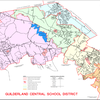GCSD hopes to triangulate public’s priorities for next year’s $118M budget
GUILDERLAND — While the school district here seeks more ways to engage the community in the budget process, the board learned a rollover budget for next year would total $118 million, up from $110 million this year.
That represents a roughly 7 percent increase in spending, which, with additional state aid, would result in a tax levy increase of 2.2 percent.
In recent years, the district has used an anonymous online ThoughtExchange to gauge community priorities in building its budget.
The board’s Dec. 6 meeting began with district resident Sara Kate Kanter describing the ThoughtExchange as “unkind and unhelpful.”
She cited the example of a woman who posted that “money is tight” although she and her husband each work two jobs, and they appreciated the free lunches provided through federal funds during the pandemic.
“There is no money to assist when you’re just above the poverty line,” the woman wrote.
Kanter reported that post got a lot of 1 and 2 ratings.
“How do these low ratings make our food-insecure families feel?” Kanter asked.
Kanter herself had posted that the district’s Diversity, Equity, and Inclusion Committee was doing an amazing job, which she said was rated as 1 while high scores were given for taking away the DEI Committee or taking DEI out of the curriculum.
Kanter said the sample of respondents is too small to represent the entire district and that the responses are not necessarily coming from different people. The ThoughtExchange, she said, is “not an equitable way to reach all district stakeholders.”
Later in the meeting, Superintendent Marie Wiles reported that there were 2,754 participants in the ThoughtExchange with 182,882 ratings, which she said was “surprising to the folks over at ThoughtExchange.” Each thought was rated, on average, more often than in any survey ever before, Wiles said.
“People were engaged, for good or maybe not-so-great,” she said.
Three different groups were polled: students; faculty and staff; and parents, guardians, and community members. More than half of the respondents were students (55 percent at 1,510) followed by parents and community members (at 34 percent or 942) and then by faculty and staff (at 11 percent or 302 respondents).
For parents and community members, class size dominated, learning resources and technology were important, and “safety was huge,” Wiles said. She also noted, “People do miss that free-lunch option.”
For faculty and staff, class size was the top priority followed by benefits, safety, and mental health.
The top priority for students was learning resources and technology, said Wiles, noting a “Wi-fi glitch” for which she said, “We have a solution.” Wiles also said, “Students are frustrated when sites are blocked.”
Students’ next priority was the free breakfasts and lunches followed by inclusive holidays.
In the future, Wiles said, students will probably have to log on to respond
She noted “a little bit of disregard for kindness” and said over 800 comments were flagged for her to review, mostly from students. “It’s all I did for a couple of days,” she said.
Some of the flagged comments were “silliness,” Wiles said, but other comments were “rude and hurtful and underscored for us how important it is to be doing diversity, equity, and inclusive work here in the district.”
School board President Seema Rivera noted the anonymity of the ThoughtExchange and also said that it is possible to “open up many browsers and post the same thing.” She said it could be “really dangerous” that the district relies on the ThoughtExchange to understand priorities.
“We don’t always have a good pulse of what the community’s feeling and so we rely on this,” she said. Rivera suggested using two or three different ways to reach the community and said, “that’s how you triangulate data.”
She said there had been racist and misogynist comments. “It becomes a platform to write extreme comments,” she said.
“This is a guide,” Wiles responded, noting the district is still early in its budget-building process.
Asked by board member Nathan Sabourin how other districts get community input, Wiles said, “A lot of our neighbors aren’t doing a lot of community outreach.”
For decades, Guilderland had a Citizens’ Budget Advisory Committee that met regularly for months each year, hearing from and questioning different school administrators in open sessions that, in later years, were televised.
After that, recalled Gloria Towle-Hilt, the board’s longest serving member, “community conversations” were set up.
“We couldn’t get people to come out ….,” said Towle-Hilt. “We weren’t getting the input we wanted.”
Wiles noted that, during the recession in 2010, the meeting hall would be packed with people who wanted to talk about priorities as drastic budget cuts were being made. “Over time, people stopped coming,” she said.
Going forward, Towle-Hilt suggested focus groups “so we can hear and give people a voice.”
Wiles said that Principal Michael Piscitelli is now holding focus groups with high school students, and that soon focus groups will be held as part of an equity audit.
Rollover budget
A rollover budget assumes all staffing and programs remain the same, explained Assistant Superintendent for Business Neil Sanders.
He was making his last presentation to the school board, since he is retiring after 18 years, and received two rounds of applause and a standing ovation.
As always with school budgets, the lion’s share of expenses would be for salaries and benefits.
Roughly $49 million would be spent on instructional salaries with about $12 million on salaries for support staff. Benefits would total about $30 million.
The next biggest expense would be for debt service at about $9 million, up from about $5.6 million this year. That is because of four capital projects — three at the schools and one at the public library — as well as because of money the district borrowed to pay for tax certiorari cases.
State aid for next year is projected at $35.7 million up from $29.7 million this year. “Schools in New York State were underfunded … for many, many years,” said Sanders, noting this is the second year the legislature has increased funding.
The rollover budget figures show that the district will take the same amount from its reserves as this year, $470,514, and the same amount from its fund balance: $470,514. That leaves roughly $80 million to come from the tax levy on local property.
Buses
In addition to the budget, voters in May will also decide on a proposition to purchase new school buses.
Inho Suh, the district’s transportation supervisor, said he plans to follow the district practice of the last several years and purchase eight new buses next year. Six would hold 65 passengers and two would hold 35 passengers — for a total cost of $1,126,600.
“The prices have jumped,” he said, but he had received a proposed price for buses as long as a letter of intent is signed by Jan. 1.
Suh said that, because of bell times and drivers who delayed retiring, “We were able to bring four schools into our in-district runs.” This saved the district “significant funds,” Suh said, since those runs didn’t have to be outsourced.
The current fleet, Suh said, is almost half diesel (40 buses) and half gas (41 buses).
He is continuing with the district’s 10-year bus replacement plan and said that corrosion from winter driving is the major reason for replacement.
To combat rust, Suh said, rust protection is applied annually, buses drive through a wash with an undercarriage rinse, buses undergo a semiannual undercarriage steam clean, and annually buses are washed and hand waxed.
New York State is requiring schools to have buses that don’t use fossil fuels by 2035. These buses will cost $400,000 each, Suh said, and will require “significant” infrastructure changes.
“We will need some help to say the least,” he said.
Suh also said, “We will see what the early adopters do and learn from them …. We don’t have to be at the front of the line and learn the hard way.”
Clifford Nooney, facilities director, said he wants to buy a new truck for $80,000. A 21-year-old salt truck would be retired and a 2008 pickup truck would replace the salt truck.
Prices have increased dramatically since before the pandemic, Nooney said.
He also said, “We’ve pushed these rucks as far as possible.”



